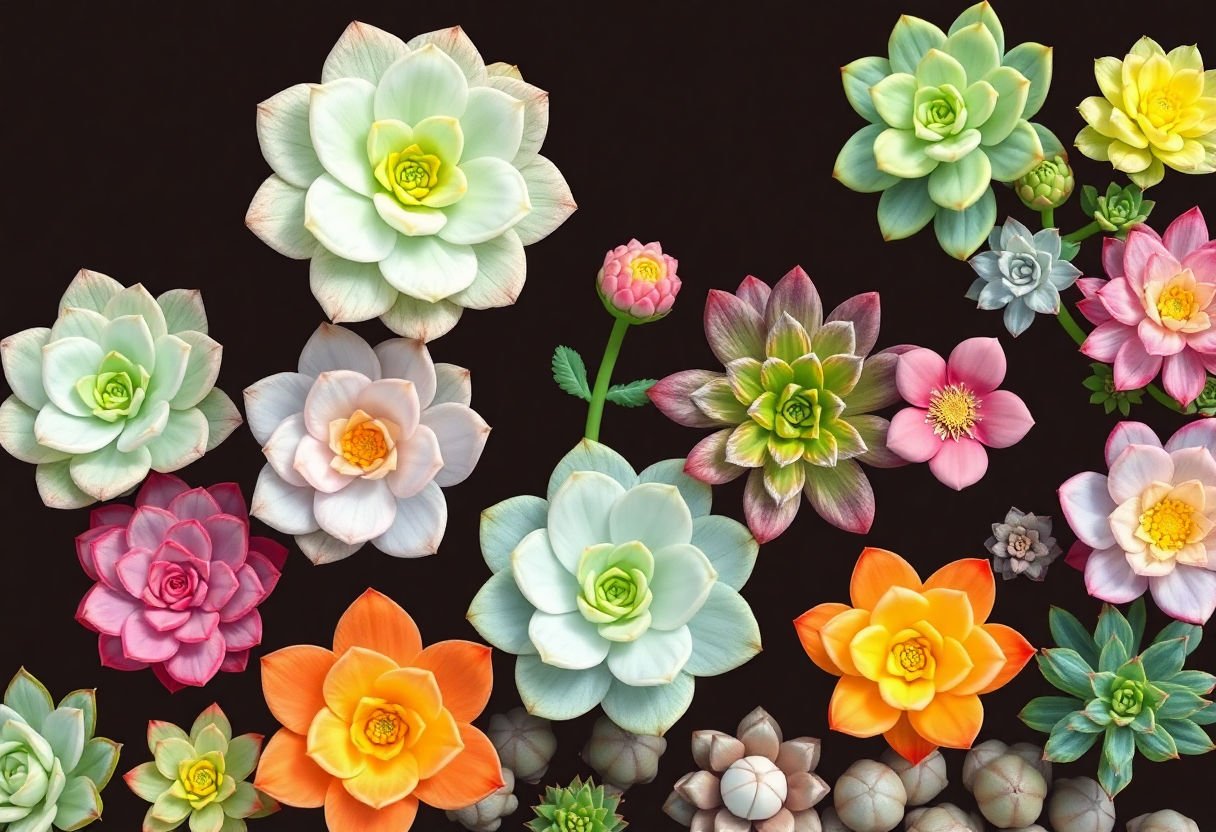Discover the vivid world of succulents, where functionality meets enchanting beauty. Our carefully curated list of the top 10 flowering succulents brings together species known for their stunning blooms and distinctive hues. From the vibrant Kalanchoe Blossfeldiana to the aesthetically pleasing Echeveria ‘Perle von Nurnberg’, these plants offer unique color palettes and easy care requirements ideal for any enthusiast. Embark on this botanical journey and find the perfect additions that promise to elevate the visual appeal of your collection, while also providing insights into maintaining their optimal health and growth.
Key Takeaways
- Flowering succulents combine the resilience of succulents with the vibrant beauty of blooming plants, making them a valuable addition to any collection.
- These plants not only enhance the aesthetic appeal of indoor and outdoor gardens but also require minimal maintenance, with dry climates and sparse watering being ideal.
- Popular varieties such as Kalanchoe Blossfeldiana and Aloe Vera offer unique visual elements, from vivid blossoms to towering flower spikes.
- Incorporating flowering succulents into your collection provides a diverse range of colors, textures, and forms, enriching your botanical display.
- Understanding the specific care requirements for each succulent type will ensure they thrive and continue to produce their striking flowers.
Kalanchoe Blossfeldiana
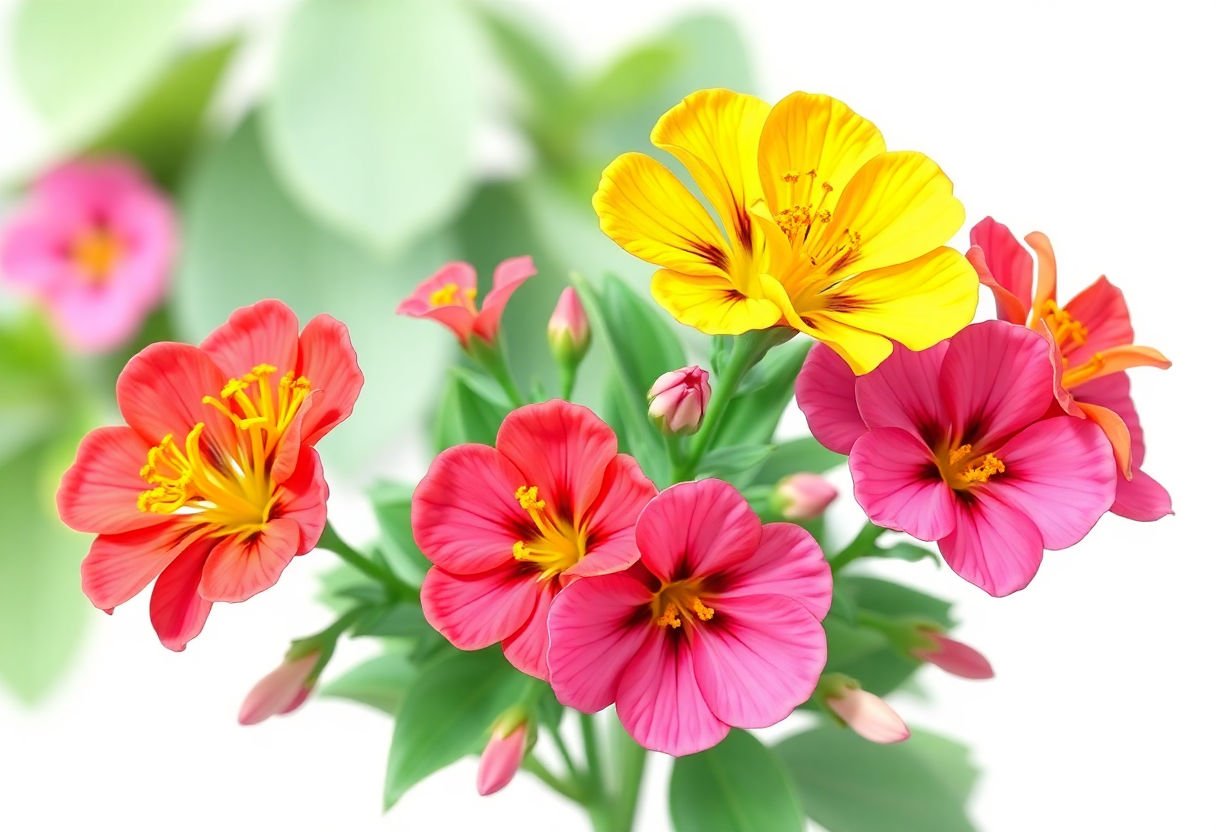
Kalanchoe Blossfeldiana, often simply referred to as Kalanchoe, is a captivating flowering succulent that adds a splash of color to any collection. Renowned for its vibrant and long-lasting blooms, this plant is a favorite among both novice gardeners and seasoned plant enthusiasts.
Originating from Madagascar, Kalanchoe Blossfeldiana has become popular worldwide due to its striking appearance and easy maintenance. Its flowers, which come in a variety of colors including red, yellow, pink, and orange, can last for several weeks, providing an extended period of enjoyment.
One of the key advantages of this succulent is its minimal care requirements. It thrives in bright, indirect sunlight, making it a perfect indoor plant. Additionally, Kalanchoe Blossfeldiana prefers well-draining soil and requires watering only when the soil becomes dry, which reduces the risk of overwatering—a common issue with succulents.
During the blooming season, which typically occurs in late winter to spring, you can enhance flowering by deadheading spent blooms. This encourages new buds to form, ensuring a prolonged display of color.
For gardeners looking to propagate, Kalanchoe Blossfeldiana can be easily propagated through leaf or stem cuttings, making it a cost-effective choice for expanding your succulent assortment.
In summary, the Kalanchoe Blossfeldiana is a must-have for anyone looking to add a pop of color and low-maintenance beauty to their home. Its ability to purify air and adaptability to various environments further enhances its appeal as a top choice in flowering succulents.
Echeveria ‘Perle von Nurnberg’
The Echeveria ‘Perle von Nurnberg’ is a captivating addition to any succulent collection, renowned for its mesmerizing pink and purple hues. This elegantly rosette-shaped succulent stands out with its smooth, plump leaves that grace a gradient of soft pink, lavender, and subtle blues. Under the right conditions, the colors intensify, making it a visual delight.
This variety of Echeveria is not only visually stunning but also relatively easy to care for, which makes it a popular choice for both novice and experienced gardeners. To keep your ‘Perle von Nurnberg’ thriving, consider the following care tips:
- Light Requirements: Prefers bright, indirect sunlight and can tolerate direct sun for a few hours. Insufficient light may lead to a loss of color vibrancy and legginess.
- Watering Needs: Like most succulents, it requires minimal watering. Water thoroughly but infrequently, allowing the soil to dry out completely between waterings.
- Soil Preferences: Well-draining soil is crucial to prevent root rot. A cactus or succulent mix is ideal.
- Temperature Tolerance: Thrives best in warm environments, but can tolerate mild frost. It’s best to bring it indoors during freezing temperatures.
With these considerations in mind, Echeveria ‘Perle von Nurnberg’ will reward you with its ethereal beauty and, at times, its charming blooms. The flowers, rising from the center on slender stalks, are delicate and typically appear in late summer or early fall, adding an extra dimension to its appeal. Incorporating this succulent into your collection not only enhances the aesthetic diversity but also introduces a refined elegance that few other plants can match.
Crassula Ovata (Jade Plant)
The Crassula Ovata, commonly known as the Jade Plant, is a revered succulent cherished not only for its aesthetic appeal but also for its symbolic significance, often associated with prosperity and good luck. This hardy plant, native to South Africa and Mozambique, flourishes indoors under adequate conditions, producing dainty, star-shaped flowers in shades of white or pale pink that are a sight to behold.
Optimal Growing Conditions:
- Light: For the Jade Plant to thrive and potentially bloom, it requires plenty of bright, indirect sunlight. Direct sunlight can sometimes scorch its fleshy leaves, so a balance is essential.
- Watering: Watering should be infrequent, allowing the soil to dry out between sessions. Overwatering can lead to root rot, a common issue with succulents.
- Temperature: This plant is best suited to moderate temperatures, ideally between 65°F to 75°F. It should be protected from freezing conditions, which can damage its leaves.
Care Tips:
- Maintain well-drained soil, and consider using a cactus mix or adding sand to improve drainage.
- Fertilize sparingly during the growing season, typically spring and summer, with a balanced, water-soluble fertilizer diluted to half-strength.
The Jade Plant is not just for experienced gardeners. Its low-maintenance nature makes it an excellent choice for beginners and an attractive addition to any indoor succulent collection. With its evergreen leaves and occasional floral display, the Crassula Ovata easily stands out, offering beauty and an air of tranquility to your living space.
Aloe Vera
Aloe Vera, often heralded for its numerous medicinal properties, also boasts a unique ability to enhance your succulent collection with its striking floral displays. Renowned for its soothing gel, which is used in various skin and health products, Aloe Vera also captivates plant enthusiasts with its tall, bold flower spikes.
These flower spikes, emerging from a dense rosette of fleshy green leaves, can reach impressive heights of up to three feet. The blooms present a cascade of tubular flowers, typically in shades of yellow, orange, or red, adding a vertical accent to your succulent ensemble.
In caring for Aloe Vera, optimal growth and flowering require specific conditions:
-
Light: Place in an area with bright, indirect light. While Aloe Vera can tolerate direct sunlight, too much exposure can cause the leaves to scorch.
-
Watering: Water sparingly, allowing the soil to dry out completely between waterings to prevent root rot. During the winter months, reduce watering frequency further.
-
Soil: Utilize a well-draining potting mix designed for succulents. This prevents waterlogging, which Aloe Vera is particularly sensitive to.
Aloe Vera is not only a hardy, low-maintenance plant but also a visually striking addition that blends both aesthetic and practical benefits. As Ralph Waldo Emerson famously said, “The creation of a thousand forests is in one acorn.” In the world of succulents, the vibrant Aloe Vera is akin to that acorn—a small addition capable of making a significant impact.
Graptopetalum Paraguayense (Ghost Plant)
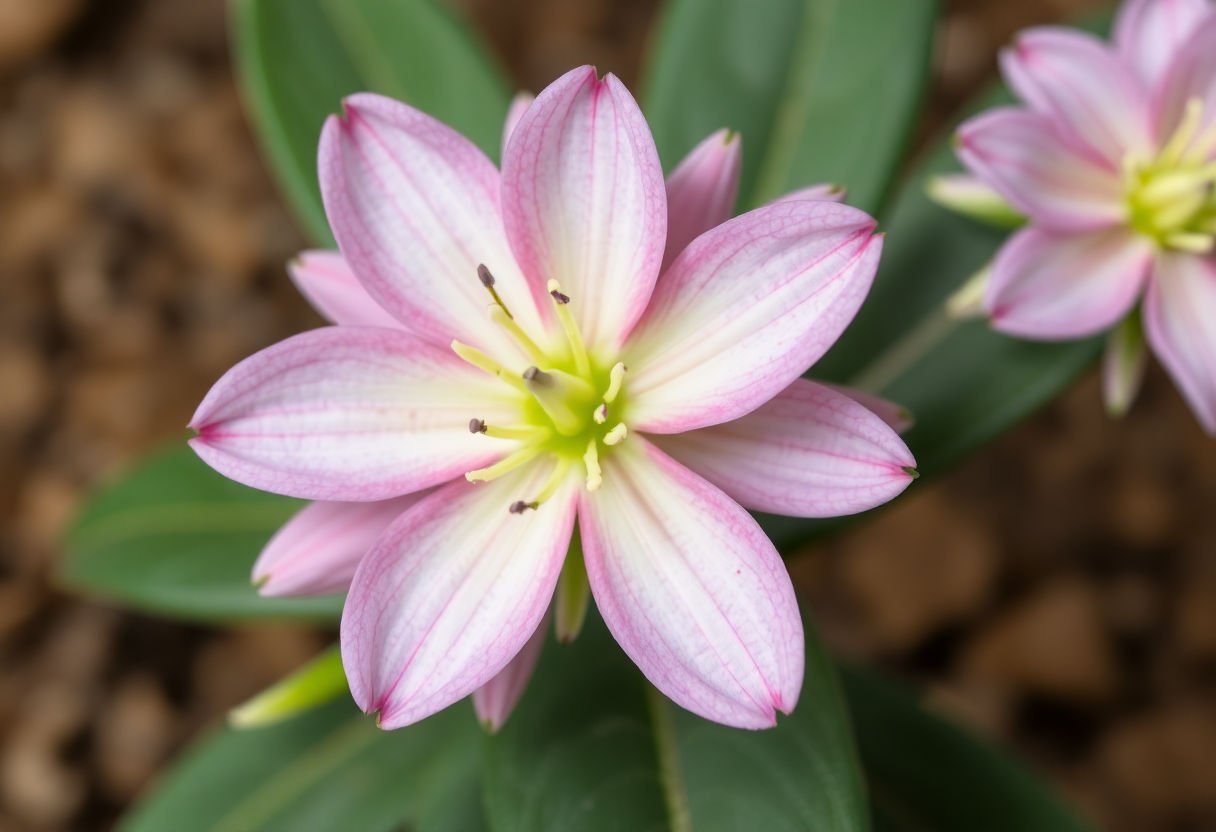
Graptopetalum Paraguayense, commonly known as the Ghost Plant, is a captivating addition to any succulent enthusiast’s collection. Renowned for its visually striking bluish-gray leaves, this succulent stands out with subtle hints of pink or purple around its edges, making it a centerpiece in succulent arrangements. Its ghostly moniker is derived from this ethereal coloration, which can change based on environmental conditions such as sunlight exposure and temperature variations.
This succulent is relatively undemanding in terms of care. It thrives best in well-draining soil and places with substantial sunlight, making it ideal for dry climates common in parts of the United States. To ensure its optimal health and flowering, it’s important to allow the soil to dry out completely between waterings, as overwatering can lead to root rot—a common pitfall for succulent growers.
One of the Ghost Plant’s most delightful features is its flowering potential. During the blooming season, typically in spring and summer, it produces charming small yellow flowers that prominently contrast against its cool-toned leaves. These blooms add a burst of sunshine to its otherwise muted palette, creating a delightful spectacle in any garden or indoor setup.
For those aiming to propagate their collection, the Ghost Plant offers an added advantage: it propagates easily from leaf cuttings. Simply pluck a healthy leaf, allow it to dry, and plant it in suitable soil. With minimal effort and attention, you’ll soon see new growth, allowing you to expand your collection effortlessly.
Sedum morganianum (Burro’s Tail)
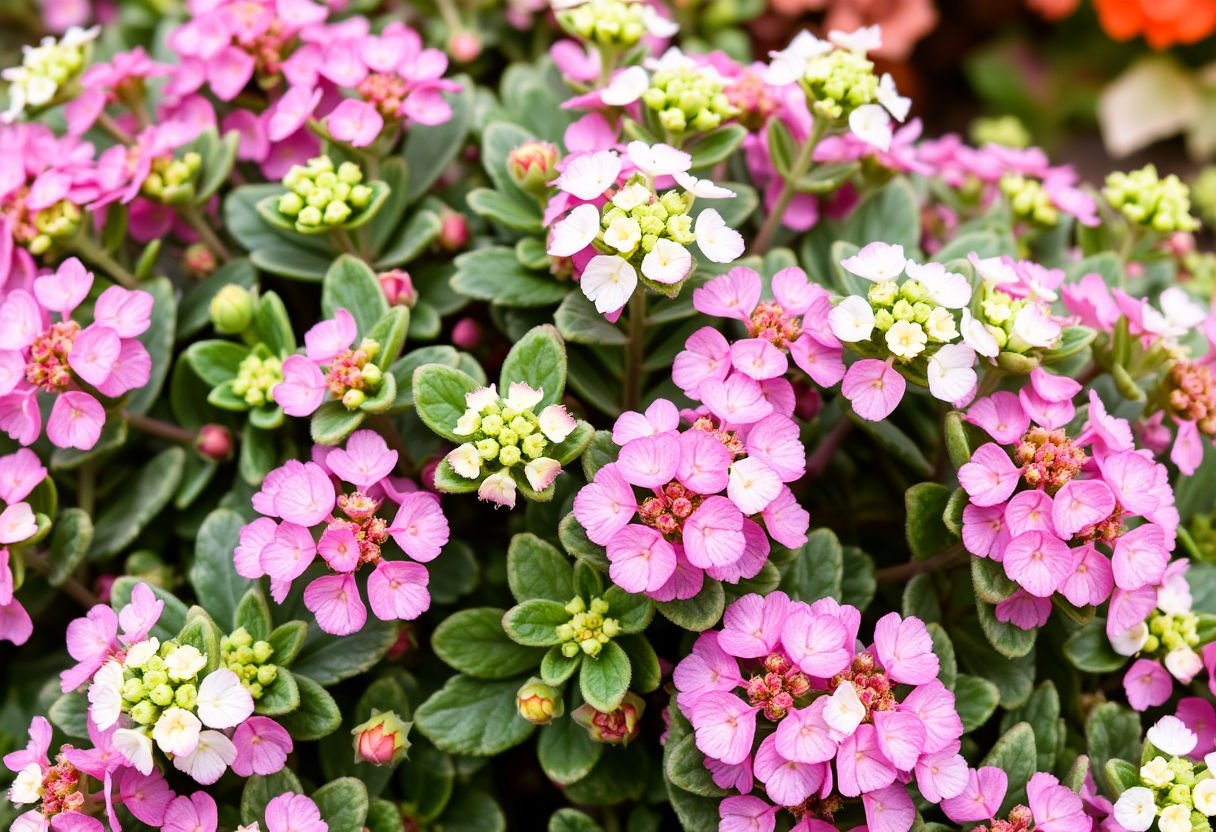
Admire the Burro’s Tail, renowned for its uniquely long trailing vines adorned with small, bluish-green leaves that resemble a series of plump berries. Native to southern Mexico and Honduras, Sedum morganianum stands out in the world of succulents due to its cascading growth habit, making it an excellent choice for hanging baskets or elevated planters.
This succulent not only captivates with its verdant foliage but also surprises with its charming pink to red flowers. If conditions are ideal, the Burro’s Tail produces these blooms during the summer months, accentuating the lush, trailing stems. Although flowering may not be its primary attraction, the occasional blooms add a delightful element to its overall beauty.
Care Tips for Sedum morganianum:
-
Light Requirements: This plant thrives in bright, indirect sunlight. While it can tolerate some direct sun, excessive exposure may lead to leaf burn.
-
Watering: Like most succulents, the Burro’s Tail prefers a “soak and dry” method. Ensure the soil is thoroughly dried out between waterings to prevent root rot.
-
Soil Type: Use a well-draining cactus or succulent mix. Good drainage is essential to maintain the plant’s health.
-
Temperature and Humidity: It favors warm, dry conditions typical of its native habitat and should be protected from frost.
By incorporating Sedum morganianum into your succulent collection, you’ll enjoy a visually interesting plant that offers both aesthetic appeal and relatively low maintenance. Its versatility and charm make it a favorite among enthusiasts looking to add a touch of elegance to their indoor or outdoor spaces.
Pachyphytum Oviferum (Moonstones)
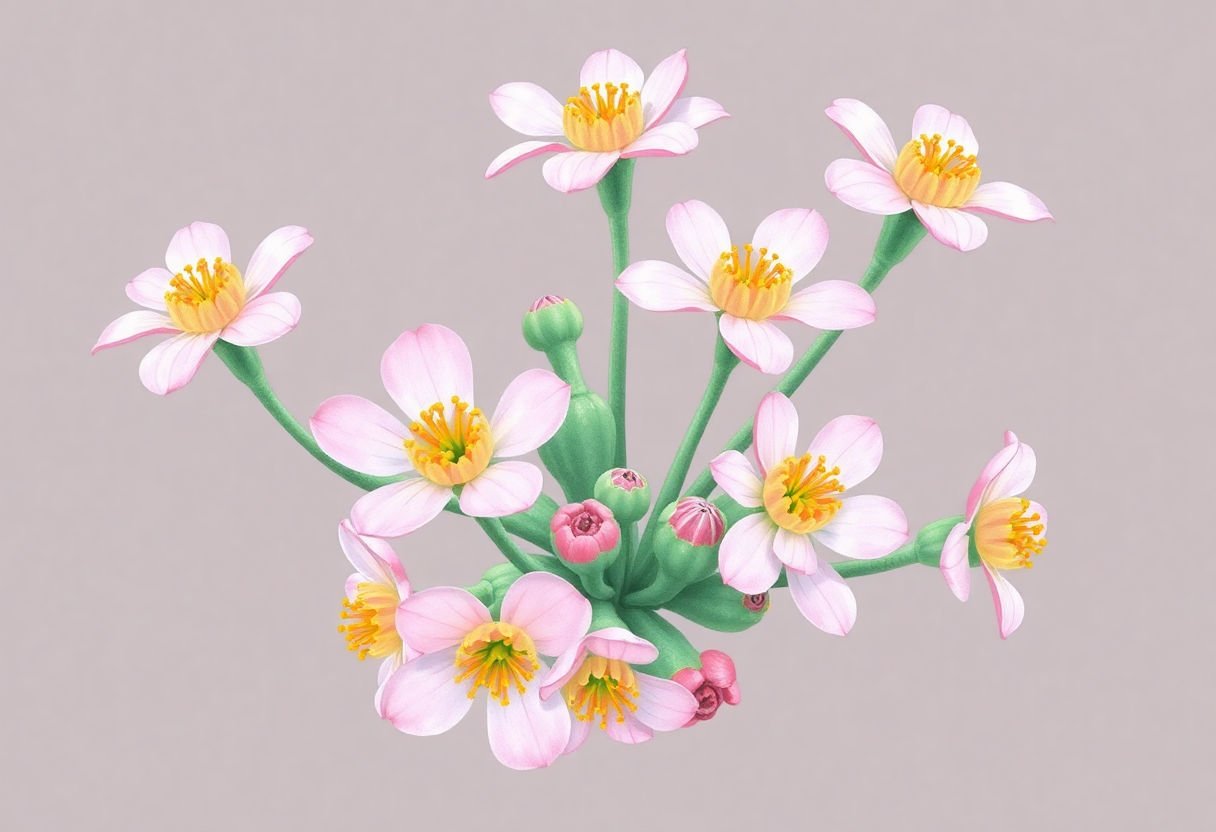
Pachyphytum Oviferum, commonly known as Moonstones, is a truly captivating addition to any succulent collection. Native to Mexico, this distinctive plant is valued for its smooth, plump leaves that resemble polished stones, hence the name “Moonstones.” The leaves exhibit a stunning range of colors, from pale blue to delicate pink, often coated with a powdery, protective layer.
One of the highlights of cultivating Pachyphytum Oviferum is its delightful, though modest, flowering display. The plant produces small, bell-shaped flowers on an arching stem, typically blooming during the spring. These flowers are often a subtle pink or white, complementing the muted hues of the leaves and adding a gentle splash of color.
When caring for Moonstones, it’s crucial to remember that they thrive in bright, indirect sunlight. Direct exposure to harsh rays can cause leaf burn. It is also essential to water these succulents sparingly, allowing the soil to dry out entirely between waterings to prevent root rot. Ideal for those seeking low-maintenance plants, Pachyphytum Oviferum requires minimal intervention to flourish.
Repotting these succulents every couple of years to refresh the soil and allow for growth is recommended, considering their preference for well-draining soil mixes. Another critical consideration is maintaining a stable environment, as Moonstones are sensitive to extreme temperature fluctuations.
Benefits of Pachyphytum Oviferum:
- Low-maintenance care requirements.
- Aesthetic appeal with its unique, stone-like appearance.
- Compact size suitable for indoor gardens and small spaces.
Incorporating Pachyphytum Oviferum into your collection not only enhances visual interest but also offers the satisfaction of nurturing a resilient and graceful plant.
Senecio Rowleyanus (String of Pearls)
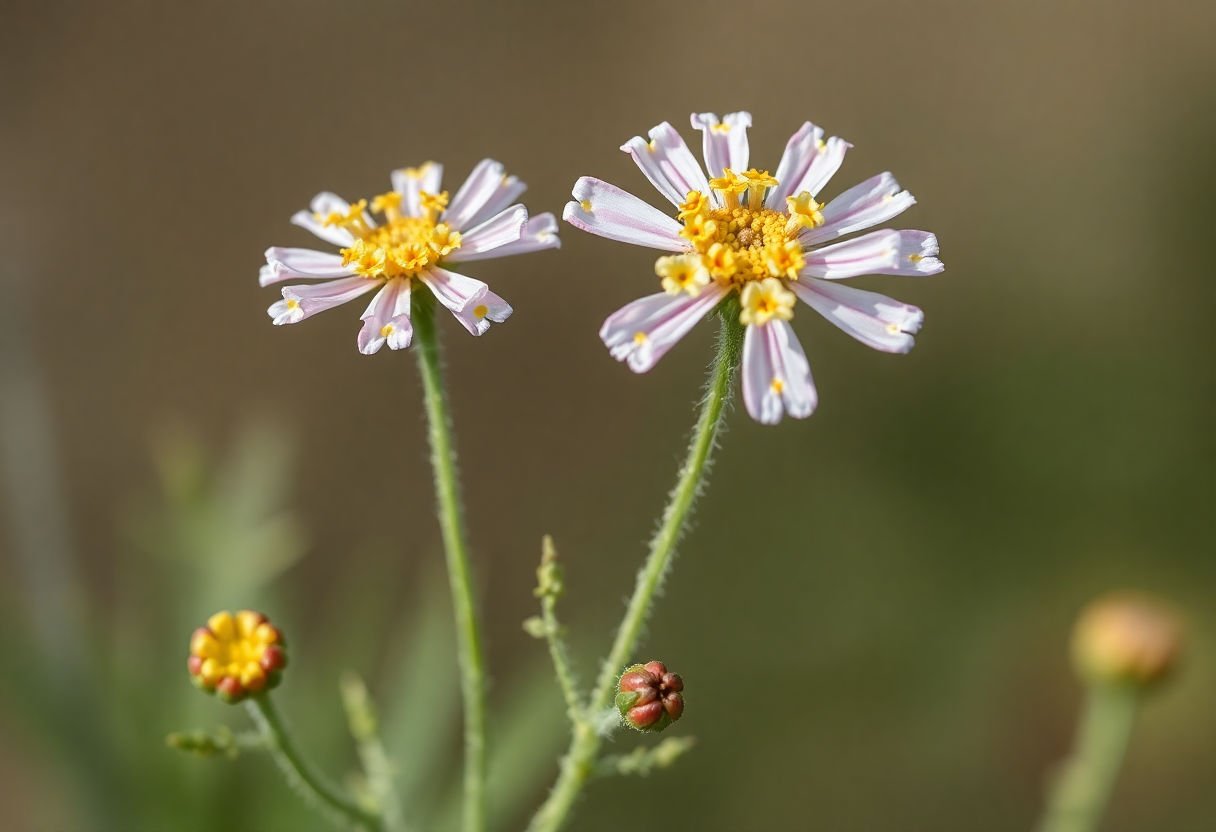
Senecio Rowleyanus is an intriguing addition to any succulent enthusiast’s collection, known for its distinctive bead-like foliage. Commonly referred to as the String of Pearls, this cascading plant captivates with its whimsical appearance and delicate, fragrant flowers.
These succulents thrive in bright, indirect light and prefer well-draining soil, ensuring that excess water does not lead to root rot. It’s essential to mimic their native arid environments by allowing the soil to dry out completely between waterings. During the growing months in spring and summer, water sparingly and reduce frequency in the dormant winter season.
The String of Pearls eventually blooms with tiny, white, cinnamon-scented flowers. Though their flowers are petite, they emit a pleasant aroma reminiscent of vanilla. This unexpected feature adds a charming sensory dimension to the plant’s visual appeal.
When it comes to repotting and propagation, Senecio Rowleyanus is quite versatile. The plant can be propagated through cuttings, an easy process that involves cutting strands and planting them directly in soil. This characteristic allows for expanding your collection or sharing with friends.
Care tips to maintain the String of Pearls involve shielding it from frost and providing ample sunlight, although avoiding direct rays prevents scorching. If grown indoors, placing them near a south or east-facing window often yields the best results.
Incorporating Senecio Rowleyanus into your collection not only adds unique texture and form but also offers an aromatic bonus during its blooming phase, making it a fascinating plant for both novice and experienced gardeners alike.
Conclusion
Flowering succulents offer a uniquely captivating way to enhance any collection, with their vibrant hues and diverse forms. From the hardy Kalanchoe Blossfeldiana to the tranquil Senecio Rowleyanus, each succulent discussed promises both aesthetic delight and minimal maintenance. As you integrate these beauties into your space, consider their ideal growing conditions to ensure sustained blooms. Embrace their variety and the joy they bring, as such plants not only beautify homes but also contribute to a serene environment. Cultivating these succulents can lead to a greener, more inspiring future within your living spaces.
Frequently Asked Questions
What are the ideal growing conditions for flowering succulents?
Flowering succulents thrive in well-draining soil with sufficient sunlight exposure—ideally six hours of direct sunlight daily. They prefer a dry climate with moderate temperatures, though some species can tolerate cooler conditions.
How often should flowering succulents be watered?
Watering should be done sparingly; allow the soil to dry out completely between waterings. Overwatering can lead to root rot, so during the growing season, water approximately every two weeks, reducing frequency in the dormant periods.
Do flowering succulents require special fertilizers?
While not necessary, flowering succulents may benefit from a diluted, balanced, or low-nitrogen fertilizer applied during the growing season to encourage more vibrant blooms.
Can flowering succulents be grown indoors?
Yes, many flowering succulents can be successfully grown indoors provided they receive adequate sunlight, either through placement near a south-facing window or the use of grow lights to simulate natural conditions.
How can I encourage my succulents to bloom?
Ensuring optimal light exposure, proper watering practices, and a suitable environment that mimics their natural habitat during growth phases are crucial. Additionally, a brief rest period with cooler temperatures and less water can stimulate blooming.
